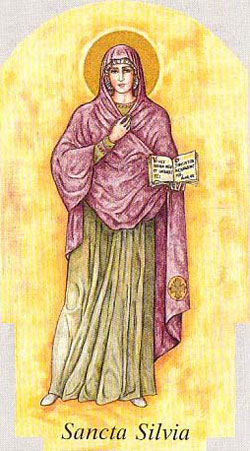
Feastday: November 5
Patron: of Pregnant Women
St. Sylvia, Mother of St. Gregory the Great (Feast - November 5) The Church venerates the sanctity of Sylvia and Gordian, the parents of St. Gregory the Great, as well as his two aunts, Tarsilla and Emiliana. St. Sylvia was a native of the region of Sicily while St. Gordian, her husband, came from the vicinity of Rome. They had two sons: Gregory and another whose name has not survived the ages. Gordian died about 573 and Gregory converted his paternal home into a monastery. Sylvia therefore retired to a solitary and quasi-monastic life in a little abode near the Church of St. Sava on the Aventine. It became her custom frequently to send fresh vegetables to her son on a silver platter. One day, when Gregory found himself with nothing to give a poor beggar, he presented him with the platter. St. Sylvia is thought to have gone on to her heavenly reward between 592 and 594. After her death, the holy Pontiff had a picture of both his parents depicted in the Church of St. Andrew. In the sixteenth century, Pope Clement VIII had St. Sylvia inscribed in the Roman Martyrology.
Not to be confused with Silvia Saint.Saint Silvia (Sylvia) (c. 515 – c. 592) was the mother of Saint Gregory the Great. She is venerated as a saint by the Catholic Church and Eastern Orthodox Church, which names her a patroness of pregnant women.
Life
Little biographical information about her exists. Her native place is sometimes given as Sicily, sometimes as Rome. Apparently she was of as distinguished family as her husband, the Roman regionarius, Gordianus. She had, besides Gregory, a second son, whose name did not survive through the ages.
Silvia was noted for her great piety, and she gave her sons an excellent education. After the death of her husband, around 573, she devoted herself entirely to religion in the "new cell by the gate of blessed Paul" (cella nova juxta portam beati Pauli). Gregory the Great had a mosaic portrait of his parents executed at the monastery of Saint Andrew; it is minutely described by Johannes Diaconus (P.L., LXXV, 229-30). Silvia was portrayed sitting with the face, in which the wrinkles of age could not hide the beauty; the eyes were large and blue, and the expression was gracious and animated.
Veneration
 San Saba seen from outside the external wall.
San Saba seen from outside the external wall.
The veneration of Saint Silvia is of early date. She was honoured by the Romans as a type of a Christian widow.
Silvia had built a chapel in her house. In 645, the monks from the monastery of Mar Saba (Palestine) settled in this house, and devoted it to the celebration of Saint Sabas. In the 9th century an oratory was erected over her former dwelling, near the Basilica of San Saba.
Pope Clement VIII (1592–1605) inserted her name under 3 November in the Roman Martyrology. She is invoked by pregnant women for a safe delivery.
Two of her relatives, sisters-in-law Trasilla and Emiliana, are also venerated as saints, as well as her other sister-in-law Gordiana, and her husband Gordianus.





